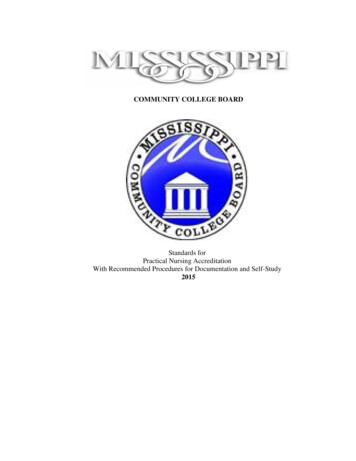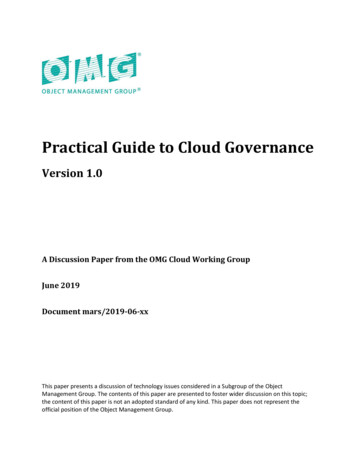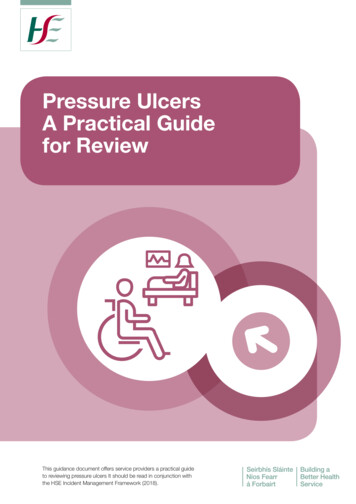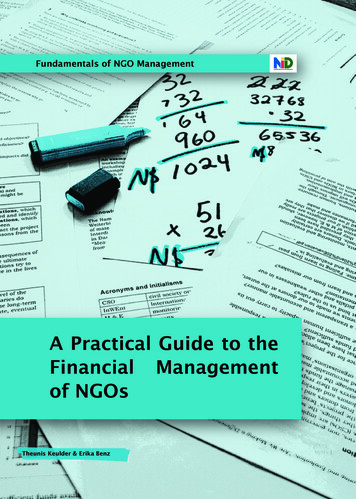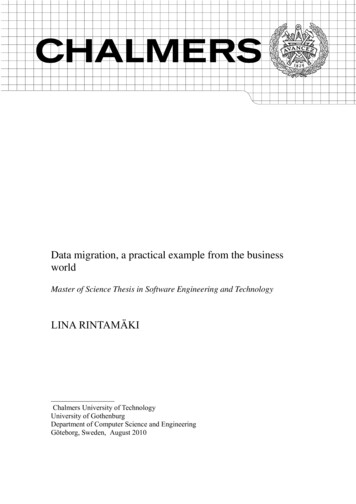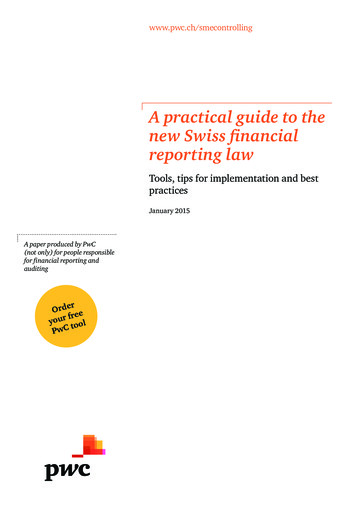
Transcription
www.pwc.ch/smecontrollingA practical guide to thenew Swiss financialreporting lawTools, tips for implementation and bestpracticesJanuary 2015A paper produced by PwC(not only) for people responsiblefor financial reporting andauditingrOrde erf eyour ooltPwC
2 – A practical guide to the new Swiss financial reporting law
ForewordDear readerThe new Swiss financial reporting law entered into force on 1 January2013. The entities concerned must implement the new provisions forannual accounts from the 2015 financial year onwards, and for consolidated accounts from the 2016 financial year. They can also choose toapply the provisions earlier on a voluntary basis.We want to make it as easy as possible for you to implement the newSwiss financial reporting law. PwC has therefore drawn up an illustrativefinancial statement and converted it into Microsoft Excel. This tool aimsto ensure that your annual accounts comply with the requirements of thenew financial reporting law.Last but not least, our tool will save you time and money, because weare making it available to you free of charge. We would also be happy toarrange a no-obligation appointment with our experts to answer yourquestions about the new financial reporting law and to discuss the associated impact on other areas (e.g. internal planning and controlling).You can order the software by completing the attached reply card ordownload it online at www.pwc.ch/smecontrolling.We trust that you will find this paper interesting and wish you everysuccess implementing the new financial reporting law.Norbert KühnisLeader of the SME IndustrySector SwitzerlandBeat PosratschnigLeader Management & ControllingServices for SMEA practical guide to the new Swiss financial reporting law – 3
4 – A practical guide to the new Swiss financial reporting law
Contents1.An overview of the new Swiss financial reporting law1 1.1What was the goal of the revision of the accounting legislation?1.2Who is affected by the new rules?1.3What requirements do all entities have to comply with?1.4How do the requirements differ for entities of different sizes?1.5What additional financial reporting requirements apply tolarger entities? 666 7 89 1.6Who has to prepare consolidated accounts?1.7What principles have to be followed when preparing consolidated accounts? 102.Practical tips for implementing the tool 112.1General information about the PwC tool 112.2What are the minimum requirements for my entity? 122.3What is the minimum structure for the balance sheet? 122.4How does the profit and loss statement have to be structured?2.5What has to be disclosed in the notes? 142.6What information is included in the management report? 152.7How can consolidation be achieved efficiently? 163.What is the impact on internal planning and controlling?Your contacts 9 131719A practical guide to the new Swiss financial reporting law – 5
1. An overview of the new Swiss financialreporting law11.1 What was the goal of the revision of the accountinglegislation?Like the old legislation, the aim of the new law is to ensure that an entity presents accounts thatenable third parties to form a reliable judgement of its economic position.The aims of the revision were as follows: To harmonise the rules laid down in the Code of Obligations for all legal forms underprivate law To differentiate between entities according to their size To introduce clear, understandable terms and rules on the structure of accounts andvaluation To increase transparency To strengthen the rights of minority shareholders To ensure more meaningful and informative consolidated reporting To create a tax neutral solution1.2 Who is affected by the new rules?The general duty to keep accounts and file financial reports applies to sole proprietorships andpartnerships (general partnerships and partnerships limited by shares) that have achieved salesrevenue of at least CHF 500,000 in the last financial year, as well as to all legal entities (companies limited by shares, limited liability companies, partnerships limited by shares, cooperatives,and associations and foundations). For all these, the law uses the term “entities” regardless ofthe legal form of the entity in question (Art. 957 Code of Obligations [CO]). Small entities (soleproprietorships and partnerships with sales revenue of less than CHF 500,000, associations andfoundations that do not have to be entered in the commercial register, and foundations exemptfrom the audit requirement) are only subject to reduced accounting requirements.1This chapter examines selected changes to Swiss financial reporting law and does not claim to be exhaustive. For adetailed description of the new financial reporting law, please see the PwC paper “The new Swiss financial reportinglaw. An overview of the most important changes, plus the revised wording of the law”, and the legal texts set out in it.6 – A practical guide to the new Swiss financial reporting law
1.3 What requirements do all entities have to comply with?The following minimum requirements apply to all entities:PurposeAccounting (Art. 957 CO)Financial reporting (Art. 958 CO)1 Basis for financial reportingPresent economic position of the entity so that thirdparties can reliably assess it Record transactions and circumstances requiredto present entity’s economic positionAssumption Going concern AccrualPrinciples Transactions recorded completely, truthfully andsystematically Clear and understandable (Art. 958c CO) Documentary proof Reliable Appropriate given form and size of entity Include essential information Clarity Prudent Verifiability (Art. 957a CO) Same rules applied in presentation and valuation Complete No offsettingGeneral rules Compliance with recognised accountingprinciples Compliance with recognised financial reportingprinciples Duty to keep accounts Requirement to provide evidence Retention Retention period Approval Signing offComponents Accounting records Accounting vouchers Inventories Annual accounts (balance sheet, profit and lossaccount, notes; for larger entities cash flowstatement) Consolidated accounts 1 (Art. 963 CO) Annual report 2 (Art. 961c CO)12Forms ofaccountingWritten or electronicIn account or report form, with prior-year figuresCurrencyIn CHF or functional currencyIn CHF or functional currency (plus values in CHF)LanguageIn official Swiss language or EnglishIn official Swiss language or EnglishReduced requirements for small entitiesIf requestedA practical guide to the new Swiss financial reporting law – 7
The accounts are filed in the annual report. This contains the annual accounts. The annualreport must be prepared within six months after the end of the financial year and submitted tothe responsible governing body or the responsible persons for approval (Art. 958 CO).Creditors who prove a legitimate interest must also be allowed to read the annual and consolidated accounts and the relevant audit reports (Art. 958e CO). The accounting records and auditreports must be retained for ten years. Special rules apply if records and reports are retainedelectronically or in a comparable manner (Art. 958f CO).1.4 How do the requirements differ for entities of different sizes?The law lays down different accounting and financial reporting requirements depending on thesize and economic significance of the entity in question.Sole proprietorships, partnerships and legal entities (“undertakings”)SizethresholdsSole proprietorshipsand partnershipswith sales revenuebelow CHF 500,000Associations andfoundations notentered in commercial register (smallundertakings)Sole proprietor ships andpartnershipsLegal entitiesNot metExceededAuditNoNo 1No audit or limited audit(Art. 729 CO)Ordinary audit(Art. 727 CO)Financialstatementsin accordance withCOSimplified accountsof income, expenditure and assetpositionAnnual accounts Balance sheet P&L account Notes 1, 2Annual accounts Balance sheet P&L account Notes 2Annual accounts Balance sheet P&L account Notes additional information 4–– further details in notes–– cash flow statement–– annual reportFinancialstatementsin accordance with arecognisedstandardOn request ofminority shareholders(Art. 962 para.2 CO)On request ofminorityshareholdersOn request of minorityshareholdersOn request of minorityshareholdersRequired to have ordinary audit?Listed companies,cooperatives with2,000 membersor more, largefoundations2 out of 3 criteria in 2 successive years: 3Balance sheet total: CHF 20 m;Sales revenue: CHF 40 m;Headcount: 250 full-time positions on annual averageOrdinary audit(Art. 727 CO)Mandatory(Art. 962 CO)1Partnerships are subject to a statutory audit if a personally liable partner demands financial statements in accordance with a recognisedstandard or if the company voluntarily prepares group financial statements in accordance with a recognised standard and has these audited.(Art. 962 para. 2 (3) in conjunction with Art. 962a para. 3 CO and Art. 962 para. 3 in conjunction with 963b para. 2 CO). Limited partnersmay demand that an audit be carried out by an expert (Art. 600 para. 3 CO).2Sole proprietorships and partnerships (but not legal entities) are not obliged to produce notes to their financial statements(Art. 959c para. 3 CO).3The following criteria apply to associations: balance sheet total of CHF 10 million; revenues of CHF 20 million and 50 full-time employees(Art. 69b para. 1 SCC). An association member with personal liability or an obligation to make additional contributions may demand a limitedaudit.4Companies that are part of a group are not obliged to provide this additional information unless qualified minorities demand this additionalinformation (Art. 961d CO).8 – A practical guide to the new Swiss financial reporting law
1.5 What additional financial reporting requirements apply to largerentities?Larger entities are defined as those that are required by law to have an ordinary audit (as per Art.727 CO). These entities must provide additional information in the notes to the annual accounts (on long-term interestbearing liabilities and the fees paid to the auditor) (Art. 961a CO), prepare a cash flow statement (Art. 961b CO) and prepare a management report.The management report should – as a supplement to the annual accounts – provide informationon the conduct of a risk assessment, orders and assignments, research and development activities and extraordinary events. It should also include a statement about future prospects (Art.961c CO) and indicate the annual average number of full-time positions (Art. 961c OR).These additional requirements may be dispensed with if the entity is part of a group that prepares consolidated accounts in accordance with a recognised financial reporting standard, provided a qualified minority does not request this additional information (Art. 961d CO).1.6 Who has to prepare consolidated accounts?If a legal entity (an incorporated company, association or foundation) controls one or more entities that are required to file financial reports, in addition to annual accounts the entity must prepare consolidated accounts in the annual report for all the entities controlled.Sole proprietorships and partnerships are exempt from the consolidation requirement.A legal entity is deemed to control another entity if it: holds the majority of the voting rights in the highest management body has the right to appoint or remove the majority of the members of the supreme management or administrative body is able to exercise a controlling influence on the entity based on the articles of association,foundation deed or comparable instruments.A legal entity is exempt from the requirement to prepare consolidated accounts if together withthe controlled entity it has not exceeded two of the following thresholds in two successive financial years: Total assets of CHF 20 million Revenue of CHF 40 million An annual average of 250 full-time positions.Sub-groups are also exempt from the consolidation requirement if the controlling entity’s consolidated accounts have been prepared, audited and made available in accordance with regulationsequivalent to the Swiss law (Art. 963a para. 1 ciph. 2 CO).A practical guide to the new Swiss financial reporting law – 9
Associations, foundations and cooperatives (but not companies limited by shares or limited liability companies) may delegate the duty to prepare consolidated accounts to a controlled entityprovided the controlled entity concerned brings all the other entities together under single management and actually exercises control.Consolidated accounts must be prepared in any case where this is necessary to make the mostreliable assessment of the economic position. Company members who represent at least 20% ofthe basic capital, 10% of the members of a cooperative, 10% of the members of an association ora foundation supervisory body, or a company member or an association member subject to personal liability or a duty to pay in further capital may also demand that consolidated accounts beprepared.The requirement that companies limited by shares and limited liability companies have boththe annual accounts and the consolidated accounts approved by the annual general meeting ofshareholders or annual general meeting of members continues to apply (Art. 698 CO andArt. 804 CO).1.7 What principles have to be followed when preparing consolidatedaccounts?Listed companies (if required by the stock exchange), large cooperatives (with at least 2,000members) and foundations required by law to undergo an ordinary audit must prepare financial statements in accordance with a recognised financial reporting standard (Swiss GAAP FER,IFRS, IFRS for SMEs, US GAAP or IPSAS) (Art. 963b CO).The consolidated accounts of other entities are governed by recognised financial reporting principles. However, they need not apply any recognised financial reporting standards, meaning thatthey are to a large extent free to choose any consolidation and valuation rules they wish withinthe scope of recognised accounting principles. As under the old provisions governing companieslimited by shares, they have to specify the rules used in the notes to the consolidated accounts(Art. 963b para. 3 CO).However, in such cases company members who represent at least 20% of the basic capital, 10%of the members of a cooperative, 10% of the members of an association or a foundation supervisory body, or a company member or an association member subject to personal liability or aduty to pay in further capital may require that consolidated accounts nevertheless be prepared inaccordance with a recognised financial reporting standard.10 – A practical guide to the new Swiss financial reporting law
2. Practical tips for implementing the tool.After concentrating on the theoretical requirements of the new financial reporting law in theprevious chapter, we will now discuss how to implement it. PwC has designed a tool (referred toas the PwC tool) to make it easier for you to apply the new Swiss financial reporting law. It alsoaims to ensure that your annual accounts comply with the requirements of the new financialreporting law. Finally, our predefined template for annual financial statements will save youtime and money!In the following paragraphs, we will demonstrate the main functions of the PwC tool with thehelp of selected screenshots. We would be happy to arrange a personal appointment to explainhow the PwC tool works in more detail and to answer any questions you may have about the newfinancial reporting law.2.1 General information about the PwC toolThe PwC tool for the new Swiss financial reporting law is divided into different sections as follows (each on a separate MS Excel sheet):1.2.3.4.5.6.7.8.General informationCover sheetBalance sheetProfit and loss statement according to nature of expense or activity-based costing methodCash flow statementNotesAppropriation of earningsSample management report and checklistThe different sections are interconnected. The advantage of this is that data only needs to beentered once and – where relevant – will be copied into the other sections (e.g. cash flow statement) automatically. The key functions are as follows:Sections marked grey are input fields.Sections marked white are fields that are calculated automatically on the basis of the dataentered.Text formatted in red shows whether or not the built-in controls have detected an error.More detailed information can be found on the first sheet, “General information”, in the PwCtool. Individual pages are formatted so that you can print out your annual accounts directly – allyou need to do is add your logo.A practical guide to the new Swiss financial reporting law – 11
2.2 What are the minimum requirements for my entity?Before using the PwC tool, you should give serious thought to which provisions of the new lawapply to your entity. As so many different exceptions exist, we advise you to discuss your situation with your auditor. We would be happy to help if you need any further information.2.3 What is the minimum structure for the balance sheet?The law now defines a number of key terms in the provisions governing the balance sheet:Items must be recognised as ASSETS if, according to Art. 959 para. 1 CO, they may be disposed of due to past events a cash inflow is probable their value can be reliably estimated.Liabilities must be recognised as LIABILITY if, according toArt. 959 para. 5 CO, they have been caused by past events a cash outflow is probable their value can be reliably estimated.SHAREHOLDERS’ EQUITY must be shown and structured in the required legal form(Art. 959 para. 7 CO).This structure must be adapted if necessary to take account of the entity’s business activity or toenable third parties to assess its asset or financing position. Receivables and liabilities vis-à-visdirect or indirect participants and management bodies and vis-à-vis entities in which there is aparticipation must be presented separately on the balance sheet or in the notes to the accounts.All items that will probably be realised or are expected to fall due for payment within one year ofthe balance sheet date or within the normal operating cycle must be entered on the balance sheetas current assets or current liabilities. Assets are shown on the basis of their degree of liquidity,and liabilities on the basis of their due date. The entity’s own shares are no longer to be carried asassets, but are to be presented separately as a reduction in shareholders’ equity. Interest-bearingliabilities (financial debts) are to be shown separately to make it easier to calculate and analysekey measures, such as EBIT.Note:The “Balance sheet” section of the PwC tool shows the balance sheet structure in accordancewith the provisions of the CO mentioned above. Data is entered directly into the colouredcells. If any additional instructions need to be considered for specific items, appropriate comments have been inserted into the PwC tool (either directly as Excel comments or as footnotesat the bottom of the balance sheet).12 – A practical guide to the new Swiss financial reporting law
ABCDA Input fields: Data for the current year and – if necessary – for previous years is entered here.Alternatively you can of course incorporate links to files from your previous systems.B Calculation fields: These are generally (sub-)totals. However, some fields are calculated automatically on the basis of information from preceding sheets (e.g. change in inventories).C Footnotes: On some sheets, additional observations can be found regarding certain items.D Comments: Useful tips and information have been inserted as Excel comments for specificitems.2.4 How does the profit and loss account have to be structured?The profit and loss account can be prepared according to the period-based (nature of expense)accounting method or the cost of sales (activity-based costing) method (Art. 959b CO). If the costof sales method is used, the notes to the accounts must also show the staff costs and, as a singleitem, depreciation and valuation adjustments to fixed asset items.In recognised financial reporting standards (e.g. IFRS, US GAAP), exceptional items are tolerated only very rarely or not at all – in an attempt to avoid controversial distinctions. Particularlyin cases where there are incentives linked to the achievement of specific financial targets, entities will be more inclined to state an item of expenditure as exceptional. For the same reasons,in cases of doubt the tendency will be to state income as operational in nature. Swiss law does,however, allow extraordinary, non-recurring or prior-period costs and income. These items mustbe shown separately in the profit and loss account and explained in the notes (Art. 959c para. 2).A practical guide to the new Swiss financial reporting law – 13
Note:The PwC tool contains two sheets presenting the profit and loss statement, one with expensesclassified by nature and one with expenses classified by function. As both methods result in anidentical annual profit or loss, the data can be incorporated into the subsequent calculationsirrespective of the method chosen.Note:Built-in control calculations carried out automatically in the background in the PwC toolmust be taken into account. The annual profit or loss shown in the profit and loss statement istherefore validated according to the corresponding balance sheet items as well as the amountstated under appropriation of profit.2.5 What has to be disclosed in the notes?All entities, with the exception of sole proprietorships and partnerships, must now present notesto supplement and explain the other parts of the annual accounts.14 – A practical guide to the new Swiss financial reporting law
Note:The PwC tool helps you to draw up legally compliant notes by proposing “building blocks”containing all the relevant information. Passages that require details specific to your entity areshown in red. Information that is not relevant to your entity or that has already been coveredin the balance sheet or profit and loss statement can simply be deleted.AA Editing information (should be deleted before printing)2.6 What information is included in the annual report?The management report presents the business performance and the economic position of theentity and, if applicable, of the corporate group at the end of the financial year from points ofview not covered in the annual accounts (Art. 961c para. 1 CO). The management report therefore gives additional explanations about significant events that have occurred during the financial year.Note:As the management report is individually tailored to each entity, there is no standard templatein the PwC tool. Instead, the PwC tool contains a checklist specifying the most important elements to be included in the management report. In addition to the general business performance, information must be provided on risk assessment, extraordinary events and futureprospects, for example. The PwC tool also contains an example of a management report for asample entity.A practical guide to the new Swiss financial reporting law – 15
2.7 How can consolidation be achieved efficiently?If a legal entity (an incorporated company, association or foundation) controls one or more entities that are required to prepare financial statements, in addition to annual accounts the entitymust prepare consolidated accounts in the annual report for all the entities controlled.Drawing up consolidated accounts can be extremely expensive and time consuming dependingon the complexity of the entity. As a result, software solutions are being used more and more frequently, even by small and medium-sized enterprises. The extent to which the associated investments result in the necessary added value depends on a variety of factors, e.g. The number of entities to be consolidatedThe currencies to be taken into accountThe number of consolidation procedures per yearThe applicable financial reporting standardThe extent of additional information to be consolidated (e.g. additional managementinformation, cash flow statement) The extent of intercompany relations The existing minorities or proportionally consolidated entities The number of corporate transactions or deferrals to consolidated companiesNote:As a result of the complex nature of consolidated accounts, a consolidation function is notincluded in the free PwC tool by default. However, PwC offers a range of solutions in the fieldof consolidation – ranging from an Excel-based solution to consolidation software. Do nothesitate to contact us. We would be happy to offer you advice on the solution that would be themost cost-effective for you, with no obligation. We would of course be delighted to assist youin implementing a consolidation solution tailored to meet your needs.16 – A practical guide to the new Swiss financial reporting law
3. What is the impact on internal planning andcontrolling?The new financial reporting law in particular, and the Code of Obligations in general, do not giveany explicit instructions regarding the structure of (internal) planning and controlling.However, it is obvious that some statutory minimum requirements – for instance regarding thepreparation of the management report (Art. 961c CO) – cannot be met by financial accountingalone. This particularly concerns forward looking indicators, such as research and developmentactivities or risk and opportunity assessment in addition to non-financial key figures, such as thenumber of full-time positions or the number of orders and assignments received.The Management Information System (MIS) describes all the management information givento the management and relevant employees on a regular basis. The main aim of the MIS is toachieve transparency within the entity as efficiently as possible. Suitable control mechanismshave to be implemented to ensure that information is consistently protected against unauthorised access.Transparency: Organise and present information togive a specific insight into the management of the entityand to support decision-making.Efficiency: Provide employees with relevant management information promptly, using efficient processesand organisational structures.TransparencyControl leversDataRisk and Compliance: Constantly monitoring thecontrol levers to ensure that the right people takeresponsibility for information and have efficient accessto coherent kandComplianceControl levers: Make efficient, effective use ofprocesses, employees, data and systems, in order tosupport the activities of the entity.In practice, transparency – in plain terms – means that the MIS does not merely contain information and analyses about the company’s business performance and results. Although it is important to be aware of the reasons for positive and negative past developments, it is equally important to be able to recognise, measure and assess the drivers for the future development of salesand results. These drivers are the only factors that can be influenced actively by managementand by the board of directors.A practical guide to the new Swiss financial reporting law – 17
As far as guaranteeing efficiency is concerned, it is essential for the MIS to focus on significantfacts and contain prior comments and recommended actions for the relevant employees. Thanksto modern IT solutions, pages of figures can easily be converted into understandable, meaningful graphics. With the help of drill-down functionalities, additional details tailored to the targetaudience can be provided at the touch of a button. The manual preparation required by an entitycan be greatly reduced, without restricting the information conveyed to the target audience.All Management Information Systems are based on the needs of the decision-makers in theentity. These needs are usually defined in the corporate strategy – operationalised by a businessplan. In other words, a functional MIS must give a clear idea of how much progress an entity hasmade towards implementing its strategy – in all the different areas in which it operates.18 – A practical guide to the new Swiss financial reporting law
Your contactsOur dedicated SME advisory team has already helped many customers with tasks ranging fromdefining the contents of an MIS to setting up a related cost and performance accounting system,not to mention implementing the technical system as part of a specially-designed software solution. Our team consists of experienced experts in the fields of reporting, controlling and financial accounting. With your help, we can put together the perfect team to suit your project requirements in terms of specialist know-how, scope of responsibility, and managerial and industrialexperience. As well as providing specialist support, we would be happy to offer project management expertise or operational assistance in the event of staff shortages to meet your individualneeds.Norbert KühnisLeader of the SME Industry Sector Switzerland 41 58 792 63 63norbert.kuehnis@ch.pwc.comBeat PosratschnigLeader Management & Controlling Services for SME058 792 28 12beat.posratschnig@ch.pwc.comA practical guide to the new Swiss financial reporting law – 19
www.pwc.ch/smecontrolling 2015 PwC. All rights reserved. “PwC” refers to PricewaterhouseCoopers AG, which is a member firm ofPricewaterhouseCoopers International Limited, each member firm of which is a separate legal entity.
A practical guide to the new Swiss financial reporting law – 3 Foreword Dear reader The new Swiss financial reporting law entered into force on 1 January 2013. The entities concerned must implement the new provisions for annual accounts from the 2015 financial year onwards, and for consoli-date


